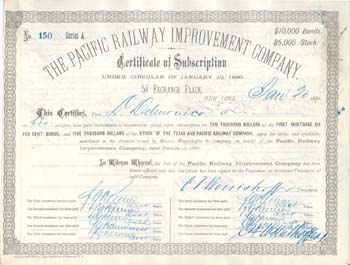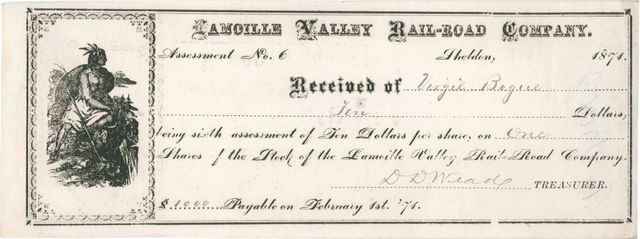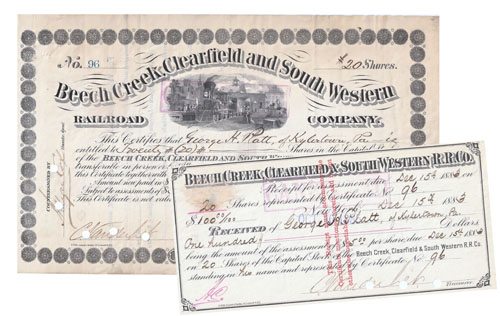Subscription, installment, and assessment receipts
Subscription receipts, installment receipts and assessment receipts are among the scarcest, most obscure, and most interesting types of all railroad receipts. They are grouped together here so they don't get overlooked among all the various receipts cataloged in this project.
Subscription receipts

It was quite common for companies to "test the waters" in order to determine whether sufficient investors would be interested in funding new plans. Maybe the company wanted to "float" a new bond issue to raise money to purchase equipment. Maybe the money was needed to extend lines into new territory. Perhaps it was creating whole new companies to tap new opportunities. Regardless of the plans themselves, companies normally advertised, frequently in partnership concert with investment banks, brokerages, and important investors. Essentially, testing the marketplace with subscriptions was like saying, "We have a hot new idea. How would you like to invest in...?"
Their goals were to entice investors to "subscribe" to new stock or bond issues. Methods were never uniform, but it appears many companies often offered bonds or shares at discounts or allowed them to make small down payments with the remainder payable over time. often formalized their efforts with "subscription receipts."
Whether plans went forward or "died on the vine," subscription receipts were intended for short-time use only. Money was either applied to the purchase of new securities or was refunded. Subscriptions were really meant as short-time "notices of intent" to invest.
As a result, subscription receipts are among the scarcest documents recorded in this project, both in types and in actual numbers. They are so scarce and purposes were so obscure that very few collectors have ever encountered them. Curiously, it is that very strangeness and rarity that keeps prices very low compared to rarity. Related indirectly to subscription receipts are the next two types of receipts, both of which are only slightly more common.
Installment receipts

As their names clearly indicate, "installment receipts" (usually with the old spelling, "instalment") represent ongoing, incremental payments for stocks or bonds after undisclosed initial payments. The receipts tend to be minimally informative, check-sized, and adorned with company name, partial-printed dates, dollar amounts, and little else. All seem to have been letterset or lithographed by local printers. Like assessment receipts below, their prices belie their rarity.
Assessment receipts

"Assessment receipts" tell a different story, partly a reflection of marketing methods and partly indicative of stock sales in the absence of promotional reality.
Assessments for amounts owed on partially paid stock
In the first case, subscription drives were intended to give companies indications of whether prospective investors were willing to fund new endeavors. What subscriptions never predicted, however, was whether they would be successful in getting subscribers to actually pay for their earlier promises. It might have been possible for a small investor in the 1860s to come up with $50 for an initial down payment on ten $50 shares. The real question was whether those same small investors could — or would — fund the remaining $450.
While evidence is sketchy, it appears railroad companies sent out assessments every one, two or three months. Not every investor was able to pay, and if they were unable to sell stock certificate quickly to another investor, their shares reverted back to companies. No reimbursements were given.
Some assessments, however, had a second origin.
Assessments for operating funds
Stock holders are part owners of companies and the percentage of the company they own is represented by their shares. Up until the early years of the 1900s, articles of incorporation of many companies were written in such a way that they were legally able to require stock holders to contribute extra money during stressful (recessionary) times or when maintenance or improvements were needed. In other words, shares were susceptible to "assessment," EVEN WHEN SHARES HAD FULLY BEEN PAID.
 July, 1883 stock certificate and matching assessment receipt for $5/share, dated five months later. Both signed by Cornelius Vanderbilt II as treasurer. Images courtesy of Steve Frasher
July, 1883 stock certificate and matching assessment receipt for $5/share, dated five months later. Both signed by Cornelius Vanderbilt II as treasurer. Images courtesy of Steve Frasher
Assessments of that nature were never welcome and attitudes against them hardened with time. The gold and silver mining industry was particularly flagrant in assessing stock holders for "necessary improvements" as mines got deeper and deeper. The deepest mines in North America were located on the Comstock Lode at Virginia City, Nevada and it is understandable that mine operators there were strong and vocal proponents of assessable stock.
Investors, especially those outside of western Nevada, were much less enthusiastic.
As arguments over assessable stock heated up in western Nevada, mines further east in Utah and Colorado began experimenting with "non‑assessable" stock. Advertisements and promotions in mining industry magazines of the 1880s and 1890s show a crystal-clear trend toward the elimination of assessable stock. At the same time, discussions about the issue in the railroad industry were almost non-existent. The microscopic number of assessment receipts extant in our hobby shine no discernible light on the subject.
Assessable stocks fell out of favor with railroad investors
Perhaps because of their greater monetary needs, it APPEARS that railroad companies were more attuned to promotional opportunities than the hard rock mining industry. While there were probably precursors, the Montgomery & Erie Railway Co. seems to have been an early adopter of the term "non‑assessable" stock as early as 1866. The Oregon Central Railroad Co. followed suit with similar naming on the opposite side of the country in 1867. About the same time, the St Joseph & Council Bluffs Railroad Co expanded the terminology on its certificates to include the phrase "fully paid and not liable to any further calls." That term took on a number of different wordings throughout the 1880s and 1890s, before solidifying into the typical "fully paid and non-assessable" phrase that appeared on millions of later certificates.
It is unclear when assessable stocks really disappeared from railroading, but one rail industry magazine, a few years after the fact, said that that all assessable railroad stocks had disappeared by 1910.
It is against that historical backdrop that three very rare 1881 stock certificates of The Nevada & Oregon Rail Road Co stand out. Those certificates are clearly labeled as part of an "assessable series" of shares. Text on the certificates say that each share was "subject to the call of the Board of Directors of five per cent per month of said par value." One must wonder whether the location of the company headquarters in Reno, only a few miles north of Virginia City and the great Comstock Lode, had anything to do with the decision to issue expensive assessable shares.
(n.b. The company secretary owned all of the three certificates mentioned above, for a total of 2,025 shares of $500 par value stock. Had the Board of Directors called for assessments, that man would have been liable for payments of up to $10,125 PER MONTH, the approximate equivalent of over $305,000 in 2023 dollars).